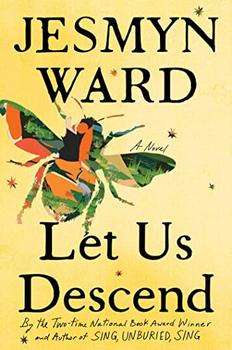Reading Guide Questions

Please be aware that this discussion guide will contain spoilers!
-
Annis describes her mother as "a woman who hides a tender heart" (page 4). Name a few moments when Mama reveals her tenderness. How does she conceal her "tender heart" and, in your opinion, what is she protecting by hiding it?
-
Turn to page 6. Read from "I take care to hide ..." to the text break on page 9 ("Queens."). Bees appear as a motif throughout the novel. According to this passage, what might bees symbolize in Let Us Descend?
-
On page 33, Annis listens through the door as her half-sisters are taught a passage from Dante's Inferno. Dante's Inferno is a literary antecedent for this book—just as Annis is accompanied on her walk south by Aza, Dante was lead through the nine circles of Hell by the spirit of Virgil. Chart Annis's journey from the Carolinas to New Orleans. Can you identify any "circles of Hell" she might have waded through? What distinguishes one from another? How did Ward's allusions to Inferno impact your reading of the novel?
-
Consider the role of spirits in Let Us Descend. They can be sinister, with selfish needs and malicious plans, or angelic guides offering counsel and comfort, and everything in between. How would you characterize Aza when she first appears to Annis in Chapter 3?
-
When she arrives in New Orleans, Annis finds a new world she has never encountered—many brown people, some even lighter than she is, are free, able to "walk through the world as if every step they take is their own" (page 92). These women avert their eyes from Annis, Phyllis, and the other enslaved people. Shortly after, a group of young boys stare at Annis, but their mother whisks them away. Why are the free people of New Orleans reluctant to look at the captives as they walk by? On the other hand, why is it so hard for Phyllis and Annis to look away from the free Black people?
-
Turn to page 113, where Annis narrates, "New Orleans is a hive, and us the honey." What do you think she means?
-
Discuss Annis's encounter with They Who Take and Give, the spirits of the ground, while she is confined to "The Hole" on pages 158 to 164. How do you characterize her emotional journey across this encounter? Does this interaction alter her perception of the spirits? Did it alter yours?
-
By cutting her hair, Annis attempts to take control over one element of her life—she severs an obvious connection to her complicated ancestry. What makes Annis's hair meaningful in this way? Why do you think she offers her hair to They Who Take and Give?
-
Consider Aza's physical changes. For example, on page 184, she shrinks, changing form so that it almost looks to Annis that they "could be sisters." Note also how Aza takes on Mama Aza's appearance throughout. Why does Aza shape shift in this way? What, if anything, is she hoping to get from Annis as a result?
-
Reflect on the events of Chapter 13. Annis, pregnant and alone in her new home, seems hopeful, healthy, and strong. From where does she draw this strength? How do you envision her new life once her child is born?
-
By the end of the novel, it is clear that Aza is an imposter—she has stolen Mama Aza's name and hungers for Annis's love and devotion. Naming is one way to preserve history and culture, and Aza admits to taking Azagueni's (Mama Aza's) name so it would live. Consider the custom, practiced throughout antebellum American history, of renaming enslaved persons so that they shared a surname with their enslavers. In this historical context, what is the power of a name?
-
Discuss the roles the various spirits play in this novel. What is their fate? How do you imagine they might endure, or not, through history and into future generations?
Enhance Your Book Club
-
Jesmyn Ward's previous books have earned her two National Book Awards, a MacArthur Fellowship, and other prestigious honors. Read Sing, Unburied, Sing: What role do ghosts play that novel? Compare Leonie and Given to Annis and Aza. Or, read Salvage the Bones: What role does nature play in that novel? How is its ferocity depicted in that novel in comparison to this one?
-
Read Beloved by Toni Morrison. How do the two books exist in conversation with one another?
-
Watch Roots, the 1977 miniseries that told the saga of American families by tracing the connection between their origins in Africa and their present in America. What is the significance of family legacy in African American history?
-
Let Us Descend is filled with references to historical practices, places, and events. Research the histories of plaçage women, the Great Dismal Swamp, and maroon colonies.
Unless otherwise stated, this discussion guide is reprinted with the permission of Scribner.
Any page references refer to a USA edition of the book, usually the trade paperback version, and may vary in other editions.

 Book Reviewed by:
Book Reviewed by:





